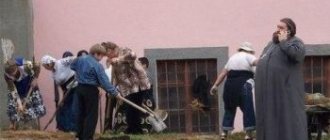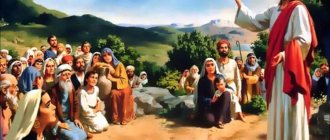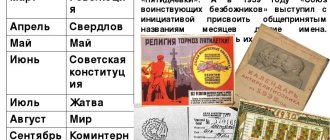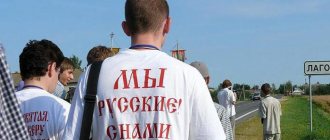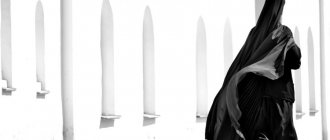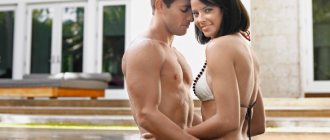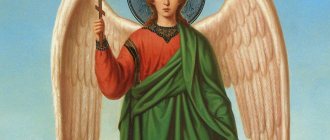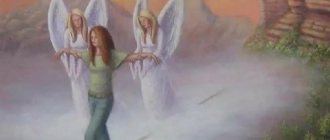Orthodox Africa: Maasai Christians
An NS correspondent went on a real African expedition to meet Christians from the Maasai tribe and pray in an Orthodox church on the border of Kenya and Tanzania, at the foot of Mount Kilimanjaro:
Orthodox Maasai
(FLV file. Duration 2 min. Size 10.2 Mb)
The Maasai are an African tribe living in the savannas of southern Kenya. Despite the development of modern civilization, they have almost completely preserved their traditional way of life; over the last century, under the influence of Greek missionaries, many Maasai converted to Orthodoxy, while Catholicism and Protestantism remained the religion of the “white” inhabitants of the country. The man in black is a Kenyan priest who cares for one of the Masai parishes.
Divine service in an Orthodox Masai temple
(FLV file. Duration 4 min. Size 20.7 Mb)
Masai worship looks very unusual, also thanks to the Swahili language, which sounds very exotic like Masai. Instead of the usual sacramental verse, the Maasai sing their own religious hymn to the drums.
There are 59 national parks in Kenya. Some brilliant people came up with and implemented a system of environmental protection zones back in colonial times, and this made it possible to preserve the unique flora and fauna of the country in its original form.
Zebras, elephants, giraffes, antelopes, rhinoceroses, lions - calmly walk around the parks, without fear of anything, since people come here only for photo hunting and safari
A safari is a tourist trip in a jeep through the savannah in search of wild animals. It is strictly forbidden to get out of the jeep - this even results in a serious fine. Each vehicle is accompanied by rangers with guns to protect tourists from wild animals.
As a rule, trips to the savannah occur early in the morning and late in the evening, at a time when animals come out of their hiding places and move from place to place in search of food.
It is considered great luck to meet all the big African five during a safari: elephant, rhinoceros, buffalo, lion and leopard. Previously, a hunter who killed at least one representative of all five was said to have collected a “grand slam” of African trophies. But today hunting is almost completely prohibited and white tourists are content with champagne surrounded by wild nature, enjoying colonial life and African hospitality
On the territory of national parks there are comfortable lodges for Europeans; they are surrounded by a fence with electric voltage - either from wild animals or from local residents - the Maasai
The Maasai are a semi-nomadic African people living on the savannah. Despite the development of modern civilization, they have almost completely preserved their traditional way of life, although this is becoming more and more difficult every year. They live in village communities on the territory of national parks. When tourism expanded in Kenya, the Maasai were unable to reap the benefits of their control over the savannahs. The tribes in power willingly recognized the traditional “ownership” of all animals for the Maasai and also transferred to them the function of protecting the reserves, while a limited group of managers from the “civilized” world took control of the tourist safari industry. As a result, tourism has practically not improved the well-being of the Maasai - they do not participate in the division of high incomes from the “white safari” and live in great poverty practically on reservations
Together with the Orthodox priest Father Mark Mwangi (rector of the Church of St. Constantine and Helena in the city of Illasit), I managed to go to such a village
And to my great surprise it turned out that most of the Maasai are Christians. There are even Orthodox Christians among them. As Father Mark told me, he knows at least four Orthodox priests from the Maasai tribe. In the photo: a Maasai woman gives Father Mark a pectoral cross, which they wove from beads for his arrival
.
Outwardly, the Maasai are very different from other Africans - they are thin, tall, with delicate features. They dress in traditional clothes - red and blue capes, and decorate themselves with beaded bracelets and necklaces. The Maasai wear sandals made from car tires on their feet.
A group of women who had gathered for a conversation with Father Mark sat down under a tree and the priest preached a sermon to them. “The Masai are for the most part already Christians,” Father Mark later told me, “and it is very easy to convert them to Orthodoxy. The fact is that the Masai and I are very similar. Both they and we, the Orthodox, hold fast to tradition. They understand why it's important. They see that I came to them in a cassock, that even this seemingly trifle is important to me, and they really appreciate it. The Maasai are very simple, kind, sincere people, not spoiled by civilization."
The elder took us around the village and showed us how they live. Despite the Maasai's reputation as fierce warriors, cattle are at the center of their culture. One of their legends says that all cattle belong to the Maasai people, and therefore everyone who also owns cattle must have stolen it from the Maasai at some point. This more than once led to serious conflicts with other tribes when the Maasai tried to return “their property”
Maasai huts built from dried dung
The situation is extremely sparse. The floor in the huts is earthen. There are no windows. Food is cooked over an open fire directly on the floor. There is no electricity, of course. But note that the elder lights his way with his mobile phone - it is charged at special kiosks in the city
Unlike many other tribes, among the Maasai women occupy an important place in the culture and life of the tribe. They are easily distinguished by their shaved heads, bright clothes and beads. In the photo: girls disinfect gourd milk vessels with smoke. After this treatment, milk is stored in them for two to three days at an outside temperature of 27-30 degrees
The Maasai drink not only milk, but also the blood of cows and goats.
In addition, removal of one of the lower teeth and circumcision are practiced for both sexes. Circumcision is performed by elders of the same sex, and boys are required to undergo the procedure without making a sound, but for girls there are no such requirements. Attempts by the Kenyan government to eradicate the practice have been unsuccessful. “My mother and I,” says Father Mark, “we go to the tribe, talk with the Masai about health, persuade them to refuse circumcision or at least disinfect the knife, otherwise mass circumcisions lead to the spread of HIV/AIDS among young people.”
Maasai traditions clearly regulate their life. Children are brought up according to age categories, between which traditional relationships are established. Boys and girls undergo initiation ceremonies. It is strictly forbidden to marry at a young age; first, men must prove themselves in war and hunting. Until recently, in order to become a warrior (moran), a young Maasai had to kill a lion. Officially, this practice is no longer used, although according to some reports it continues to exist
Beautiful clothes and beads are not a masquerade for the sake of my arrival with Father Mark. The Maasai really do constantly walk, ride their bikes to the store, and herd their herds in just such clothes. In addition, men usually carry a knife and a stick with them
The Church of St. Constantine and Helena on the border of Kenya and Tanzania, where Father Mark is the rector - the local church social department. At the temple, Father Mark organizes mass free medical appointments (medicine in Kenya is paid, so not everyone has the opportunity to meet with a doctor), cares for 60 orphans, organizes meetings of self-help groups for AIDS patients, and missionaries among the Maasai, who gladly come at his invitation for Sunday service
.
Father Mark's temple is built of corrugated iron, the floor is earthen, there is no electricity.
We brought the Russian golden vestment to the priest from Moscow - it was purchased, among other things, with donations from readers of the Neskuchny Sad magazine. Father Mark was very grateful and said that he would pray for all the donors! And he even admitted that he had never seen such beauty in his life: “Like the Patriarch’s!” In Kenya it is very difficult to buy Orthodox vestments - there are no suitable materials, few people know how to sew phelonions. Usually a priest serves in the same vestment for decades until it is completely worn out.
Father Mark reads the Gospel in local languages - Swahili, Maasai and Kikuyu
The parishioners sing the service themselves. There is no choir. Everyone knows the words by heart
Excerpts from the Gospel that will be read at the liturgy are written on the board.
Maasai in the temple
One of the most important parts of Orthodox worship in Africa is the sermon.
The Liturgy and Holy Scripture have so far been translated only into Swahili, so Father Mark has to translate and interpret the meaning of the passages read for the Maasai - into their language, for the Kikuyu - into their
The Maasai look somewhat extravagant in an Orthodox church, but they listen to the sermon with great interest, nod to the priest, and agree with him
In Orthodox churches in Africa there are chairs and benches on which you can sit during the sermon and reading of the Apostle
Father Mark was shocked by the news that in Russia there are no benches in churches. He asked us to talk about this at all meetings, supplementing this idea with the fact that, they say, in Russia, believers stand in church, before God! This is faith, this is Orthodoxy! It’s not that we are completely relaxed here... In the photo: the earthen floor in the temple altar
Altar
The Great Entrance, according to Greek tradition, is made along the perimeter of the entire temple
Teenagers and children in the temple behave very calmly, do not run, do not make noise, and do not even cry. And young people follow the service from books
.
.
After the end of the service, we distributed icons and crosses to all parishioners, which were purchased with donations collected in Moscow
It turned out that almost none of the Orthodox parishioners have crosses on their bodies - there is simply nowhere to get them and there is nothing to buy them with. We still greatly underestimate the Sofrino we have...
Meanwhile, the parish activists prepared refreshments for everyone
After the meal, the Maasai elder thanked the priest for the invitation to the temple
.
Mount Kilimanjaro is the highest mountain in Africa. It is clearly visible in Kenya, although the mountain is located in the neighboring country - Tanzania. Scientists did not believe travelers that its peak was covered with snow until the first photographs were taken. An unprecedented thing - snow at the equator!
Current situation[ | ]
The basis of the mission is financial and spiritual support from fraternal Churches and the training of students from Africa in Orthodox educational institutions in the USA and Greece.
With the founding of the Orthodox Patriarchal Seminary (Patriarchate of Alexandria) named after Archbishop Macarius III of Cyprus in Nairobi (Kenya) in 1982, the latter became the main source of Orthodox education.
The low standard of living characteristic of African countries makes it necessary, along with missionary activities and catechesis, to organize medical centers, schools, technical schools, and agricultural schools, which requires serious additional efforts and costs.
The largest Orthodox community in Africa exists in Kenya, where in the early 2000s there were about 300 parishes and 67 groups; they run 10 kindergartens, 5 primary schools, one secondary school and 3 clinics. According to the World Council of Churches, the flock numbered 620,000 people[6].
In 2021, the Orthodox Church received official status in Gabon[7].
Links
- C. Hayes.
EuropeAustria · Azerbaijan · Albania · Andorra · Belarus · Belgium · Bulgaria · Bosnia and Herzegovina · United Kingdom · Hungary · Germany · Greece · Georgia · Denmark · Ireland · Iceland · Spain · Italy · Kazakhstan · Latvia · Lithuania · Liechtenstein · Luxembourg · Macedonia · Malta · Moldova · Netherlands · Norway · Poland · Portugal · Russia · Romania · Serbia · Slovakia · Slovenia · Turkey · Ukraine · Finland · France · Croatia · Montenegro · Czech Republic · Switzerland · Sweden · Estonia
AsiaAzerbaijan · Armenia · Afghanistan · Bangladesh · Bahrain · Vietnam · Georgia · Egypt · Israel · India · Indonesia · Jordan · Iraq · Iran · Yemen · Kazakhstan · Cambodia · Qatar · Cyprus · Kyrgyzstan · PRC · DPRK · Kuwait · Republic of Korea · Laos · Lebanon · Mongolia · UAE · Oman · Pakistan · Russia · Singapore · Syria · Tajikistan · Thailand · Turkmenistan · Turkey · Uzbekistan · Philippines · Japan
AfricaAlgeria · Angola · Benin · Botswana · Burundi · Gabon · Gambia · Ghana · Democratic Republic of the Congo · Egypt · Zambia · Zimbabwe · Cameroon · Kenya · Ivory Coast · Mauritius · Madagascar · Malawi · Morocco · Mozambique · Nigeria · Republic of the Congo · Sudan · Sierra Leone · Tanzania · Tunisia · Uganda · Central African Republic · South Africa · Ethiopia
OceaniaAustralia · New Zealand
AntarcticaChurch of the Holy Trinity · Chapel of St. John of Rila · Chapel of Equal-to-the-Apostles Prince Vladimir
Emergence and development
Orthodoxy in sub-Saharan Africa came about in a variety of ways.
One of the ways
is Greek economic immigration: diasporas that emerged throughout the 20th century, in increasing numbers throughout the continent. It is clear that where the Greeks appeared, they always built a temple - as part of their religion and culture. These Greeks, for the most part, were not involved in the mission, although they could not help but attract the interest of Africans in Orthodoxy.
Another way
- this is active missionary activity, which is carried out to this day by the Patriarchs of Alexandria, starting with Meletius II (1926-1935). The fraternal assistance of the Greek, Cypriot, Russian and Finnish Churches, as well as the Greek Orthodox Archdiocese in America, plays a significant role.
And the third way
- autochthonous. “As Walbert Bühlmann argues, its (the Church of Africa's) origins are not the result of the activities of Greek Orthodox missions. Rather, we can talk about the consolidation of three disparate groups under a charismatic leadership. Having united, these groups turned to the Patriarch of Alexandria and all Africa with a request for official recognition. Although this was done in 1945, no action was taken to establish an episcopate until 1958, when the Patriarch of Alexandria appointed a metropolitan there. And even the metropolitan did not stay there permanently; his residence remained in Egypt.”[3].
The first local spiritual leader (in the 1920s) to convert to Orthodoxy was the priest of the Ethiopian Church, Daniel William Alexander.
), who entered into relations with the “African Orthodox Church,” recently formed in the USA, and was ordained bishop of this jurisdiction. In the early 1930s, Bishop Alexander traveled to Uganda at the invitation of two former Anglicans who, as a result of spiritual search, intended to become members of the Orthodox Church. Returning from Tanganyika in November 1935 to eastern Africa, he founded a seminary where he trained 8 students and subsequently ordained 2 priests and 2 deacons. The "African Orthodox Church" was accepted into the Patriarchate of Alexandria in 1946.
Notes[ | ]
- Metropolitan Hilarion (Alfeev), Archpriest Oleg Korytko, Archpriest Valentin Vasechko.
History of religions. - 2021. - P. 244. - DEMOCRATIC REPUBLIC OF CONGO
- article from the Around the World encyclopedia - https://ruvera.ru/news/hristiane_ugandy_stanut_staroobryadcami Ugandan Christians will become Old Believers
- Alexandria Church // ZhMP No. 7, 1977. P. 50.
- Stamulis I. Orthodox theology of mission today. M., 2003. P. 144.
- Kenya Archived March 11, 2008. (English)
- Gabon: The Orthodox Church has received official status / OrthoChristian.Com Ru
